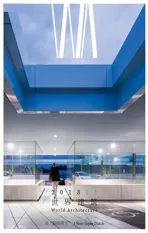非超级的荷兰性:密度,人性化尺度与健康的地球
2018-03-27张利ZHANGLi
张利/ZHANG Li
作者单位:清华大学建筑学院/《世界建筑》
此时,我的桌上摊开着两本书,每本打开的页面都是一幅由荷兰人绘制的图画。一幅是阿尔多·凡·艾克画的《欧特罗环》,收录在莎拉·怀廷的《焦虑的现代主义》一书中。另外一幅是玛德隆·弗里森多普的《现行犯》,收录于雷姆·库哈斯的《癫狂的纽约》。每幅图都表达了荷兰人对什么是建筑以及建筑为谁服务的想法。两幅图绘制的时间仅相差10多年,然而,它们背后的建筑意识形态却大相径庭。
从1990年代开始,随着北京的CCTV大厦等具有争议的地标项目的出现,荷兰人在中国建筑景观中确立了“超人”的身份。在多数人看来,他们是城市标志性的超大型建筑的终极创造者。这些建筑大胆、华丽、引人注目,它们否认重力,忽视所有已知的建筑原则。“超级荷兰人”的冲击波发出了明确无误的信息,宣告建筑是一种集体性的视觉声明:突出标志化冲击力和纪念性是建筑的至高无上使命。在这种价值观驱使下,对于一个城市来说,想要在建筑方面迅速扬名全球,恫吓可能比关爱有效得多。
然而,与荷兰长达几个世纪的人文主义传统相比,发生在21世纪初的这20年内的“超级荷兰”现象只是短暂的一瞬,我们甚至可以认为它只是漫长的荷兰人文主义线索中的一个小插曲而已。
作为人口密集的低地小国,荷兰人从很早就培养出自身与环境、与他人的和平相处之道。工业化之后,荷兰迅速崛起成为全球最重要的贸易经济体,但在军事武力上从未有相应的表现。荷兰的大都市选择聚焦于普遍生活品质的提升,无意强化帝国式的张扬。一方面,在精心填海造城圈定的宝贵土地上建造纪念性的广场或台基毫无意义;另一方面,无论是骑自行车或划船,对水平交通方式的长期执念,已经让任何垂直的东西都相形见绌。从启蒙运动到第二次世界大战,在阐释密度、人口规模和建立有利的共生环境方面,荷兰人一直源源不断提供着可供参考的范例。凡·艾克的“由我们、为我们”实际上提供了一个长镜头,让我们看到荷兰建筑这条更绵长、更执着的发展路径。
功能混合与类型学的杂交为荷兰人提供了独特的解决密度问题的方法。在1950年代的鹿特丹,正是巴克马的巴恩商业街以水平体量的并置否定了勒·柯布西耶和格罗皮乌斯的纯粹垂直体量的模型,并在战后重建期间,在现代主义的巅峰时期,首先创造了真正的街头生活(或者说得更孟浪一点,是欧洲传统城镇记忆的真正再现)。同样,半个多世纪后的几个街区之外,MVRDV设计了大市场(Markthal),将住宅和市场混合杂交,同时共享相同的城市基底,终结了超大型巨构必须是且仅是标志化建筑的时代。
激进地把缓慢、分散的运动作为优先考虑的重点,是荷兰人设计人性化尺度的城市空间时所采用的典型做法。1960年代,阿姆斯特丹有许多阿尔多·凡·艾克设计的游乐场。众所周知,当时正值每个欧洲城市都在进行乏味的功能规划的时期,凡·艾克的临时游乐场异常亲切,老少皆宜,是当时为普通欧洲公民设计的最好的开放空间。世纪之交,交通工程师汉斯·蒙德曼提出了拆除红绿灯将道路还之于人的哲学。在他死后,他的想法于2010年代后期得以实现,阿姆斯特丹亚历山大广场的所有红绿灯都被拆除,得到了骑自行车者和行人的一致好评。同样,2015年,Luchtsingel在鹿特丹竣工,它穿越办公大楼,连接了被遗忘的角落,为行人提供了一条全新的生动路线。
出于对洪水引发失地的持续担忧和对即将到来的资源短缺的高度警觉,荷兰人有充分的理由从最灵活的平面布局到最疯狂的技术解决方案无所不用其极地提升资源的使用效率和环境的可持续性。1970年代初,赫尔曼·赫兹伯格位于阿珀尔多伦的中央管理办公室成功地提供了“半进化”的分子模块空间,为使用者提供了各种可能性,并使建筑存在的时间更长久。1980年代至今,整个阿尔米尔新城都在新的环境友好的人居城市理念下进行规划、建造和生长,一切都依靠水和最先进的能源应用技术。更激进的是韦斯特兰地区,那里是新型农业温室的巨大海洋,最近刚刚投入运行。应用先进的人工照明、气候控制和层叠种植技术,这些农场全天候种植作物,其目的是用一半的资源达到比今日普通农场高一倍的产量。“小国养活全世界” 不再只是一句口号。
如上所述,我们相信,过去中国人对“超级荷兰建筑”的固有印象在根本上存在疏漏,并令人同情的过时。无论是传统,还是民族性,还是他们今天开拓性的思维和实践,都使荷兰建筑比我们熟悉的更加人性化、更加进步、更加能为当今世界提供启发。这是为什么我们觉得有必要出版《世界建筑》专辑聚焦于“非超级”的荷兰建筑的令人兴奋的新鲜景象。
我们衷心感谢卡斯·卡恩教授,他的无私帮助使这一期的出版成为可能。□
Two books are sitting open on my table, each turned to a page with a sketch by a Dutch. One isthe Otterlo Circlesby Aldo van Eyck, printed in Sarah Whiting'sAnxious Modernism. The other is Madelon Vriesendorp's Flagrant Délit, collected in Rem Koolhaas'Delirious New York. Each sketch depicts a Dutch idea about what architecture is and whom architecture is for. The dates of the sketches are more than a decade apart. The architecture ideologies behind them, however, are eons apart.
Since the 1990s, along with the arrivals of controversial landmark projects such as the CCTV Tower in Beijing, the Dutch have established themselves in the Chinese architecture landscape as supermen. They are known to be the ultimate creators of iconic urban megastructures that are bold, flamboyant, striking, denying gravity and ignoring known architectural principles. The sweeping shockwaves of the Super Dutch sent an unmistakable message about architecture as a collective visual statement: there is nothing wrong in iconography and monumentality. For a city to rapidly claim global notoriety architecturally, it is probably better to scare than care.
Yet the Super Dutch was merely a short existence, arguably two decades or so at the turn of the 21st century, compared to the centuries-long tradition of Dutch humanism. So short that it might be appropriate to call the Super Dutch period an interruption.
As a people densely populated on a small foot print of low land, the Dutch has cultivated their own way of staying at peace both with the environment and with other humans from very early on. After industrialisation, rapidly developing into a global power in trade but never in military might, the Dutch metropolitan cities had chosen to focus more on general living condition than on imperial expression. On one hand, it makes no sense to construct monumental squares or pedestals on valuable lands meticulously claimed from sea.On the other, the long obsession with horizontal mobility, either by bicycles or by boats, has relegated anything vertical to the inferior league. From Enlightenment to post WWII years, the Dutch have been an open source of reference in interpreting density, human scale and setting up conducive,symbiotic environments. Van Eyck's by us, for us certainly gives us a lens to see this longer, more consistent line of Dutch architecture.
Programmatic mix, and typological hybridity gives the Dutch a unique approach on density. In 1950s' Rotterdam, it was Bakema's Lijnbaan that denies the vertical purity in both Le Corbusier's and Gropius' models by the juxtaposition of horizontal volumes, and first created street life (or dare we say memories of traditional European towns) in post war reconstruction when modernism was still at its ruthless peak. Similarly, more than a half centuries later and a few blocks away, MVRDV made the Markthal which put the residential and the market virtually mating with each other while sharing the same foot print, putting an end to a time when megastructure is all about iconography.
Radically giving priority to slow, sporadic movement in the city is a signature Dutch approach to human scale urban space. In the 1960s there were Aldo van Eyck's playgrounds in Amsterdam.Famously interstitial and incredibly intimate,they represented some of the best open spaces for average citizens in Europe when every city was getting boringly programmatic. Closing to the turn of the century, traffic engineer Hans Monderman proposed the philosophy of removing traffic lights to give roads back to humans. After his death, carrying his idea to real life in the late 2010s, all traffic lights in Alexanderplein, Amsterdam have been removed and got the unanimous praise from cyclists and pedestrians. Similarly, in 2015, the Luchtsingel is opened in Rotterdam, penetrating office blocks and connecting forgotten patches, giving pedestrians a new fun route to take.
The everlasting danger of losing land to flooding and an extremely high awareness of impending resource shortage has given the Dutch good reasons to try everything possible for resource efficiency and environmental sustainability, from the most flexible floor layout to the wildest tech solutions. In early 1970s, Herman Hertzberger's Centraal Beheer Office in Apeldoorn managed to provide "half-evolved"molecule spaces, giving all kinds of possibilities to users and making the building inherently lasting longer. From 1980s up to now, the entire new town of Almere has been planned, constructed and occupied with the new environmentally-friendly habitat in mind. Everything relates to water and energy uses the most update technology possible.Even more radical are the sea of gigantic green houses in Westland area, recently put into running.Utilising cutting-edge artificial lighting, climatecontrol and stacked planting technology, these farms grow crops around the clock, and are designed to double the food production from half the resource compared to common modern day farms. A tiny country feeding the world is no longer a slogan.
It is exactly because of the above that we believe the general Chinese impression of the iconic Super Dutch is fundamentally flawed, and regrettably outdated. By tradition, by identity, and by their pioneering thinking and practice today, the Dutch is simply more human, more progressive, and more inspiring. That is why we feel obliged to publish this number ofWA, presenting the exciting new currents of Dutch architecture.
Our whole-heartedly thank to Professor Kees Kahn, whose generous help makes this publication possible.□
